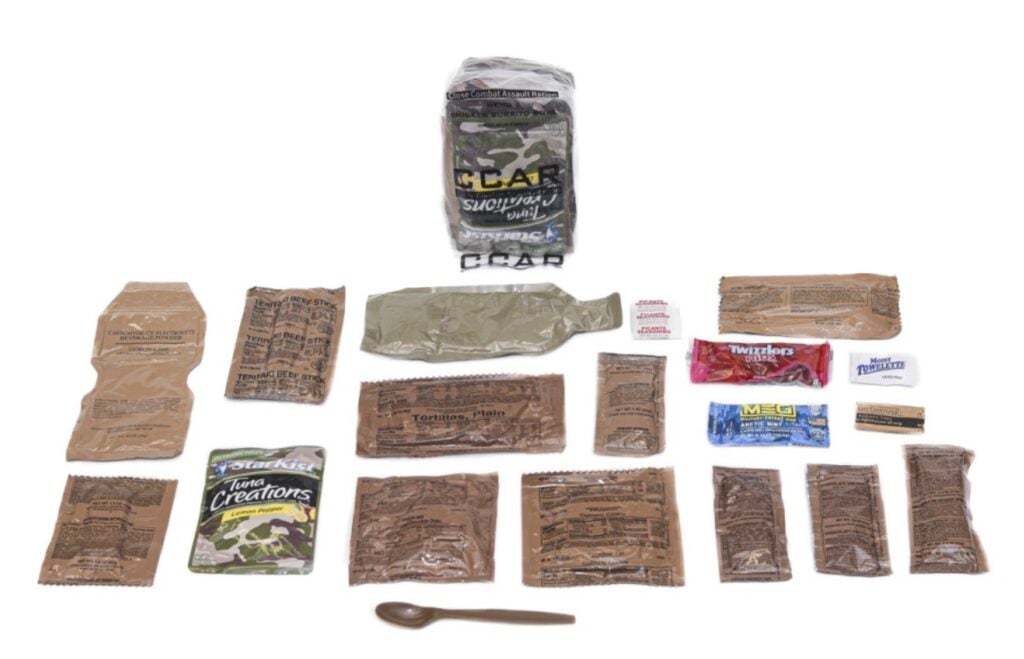After decades of jokes, complaints, and GI distress, the U.S. Army has officially replaced the brick-like MREs and FSRs with a new individual field ration designed specifically for high-mobility operations like invasions, raids, and extended missions without resupply—promising a lighter, smaller, and, most importantly, easier-to-digest alternative.
The new Close Combat Assault Ration (CCAR) is now available for procurement across all military branches through the Defense Logistics Agency Troop Support. Designed by the Army Combat Capabilities Development Command Soldier Center’s Combat Feeding Division (CFD), the CCAR marks a major evolution in field nutrition—providing troops with more energy in a significantly smaller footprint.
Designed for the Modern Battlefield
The CCAR was developed to support small, mobile units operating in austere, contested environments for five to ten days without resupply. Compared to the First Strike Ration (FSR), the CCAR reduces volume by 39% and weight by 17%, allowing warfighters to carry five days of nutrition in the space previously required for three.
Each CCAR delivers approximately 2,800 calories per day, packaged into a single, compact, shelf-stable unit. The goal was to reduce bulk without compromising energy needs, performance, or palatability—an area where traditional MREs often fell short.
Innovations in Processing and Digestibility
CCAR components are produced using sonic agglomeration and vacuum microwave drying—two emerging technologies that address common complaints about traditional rations.
Sonic agglomeration uses vibration and compression to bind food particles at the molecular level, eliminating the need for synthetic binders or fillers. This results in compact, high-density food items that retain their original ingredients and nutritional content without the gut-clogging density of traditional bars or compressed meals.
Vacuum microwave drying, used for select components, removes water while retaining internal moisture. The result is a smaller, lighter product that doesn’t turn into dry, brittle paste in the field.
Together, these technologies allow the CCAR to pack a day’s worth of nutrition into a more digestible form—without sacrificing shelf life or taste.
Backed by Testing and Troop Feedback
In 2021, the Army conducted a five-day operational test and evaluation (IOT&E) with the 82nd Airborne Division at Fort Polk, Louisiana, and the Marine Corps’ 2nd Light Armored Reconnaissance Battalion at Fort Pickett, Virginia. Servicemembers consumed CCAR prototypes exclusively for five days without resupply.
The results were clear: troops consuming the CCAR ate more, experienced fewer energy deficits, and saw no decline in physical performance. Although the Army’s official report doesn’t mention it outright, the improved intake and energy balance observed during CCAR testing strongly imply better digestibility—potentially addressing the constipation and GI discomfort long associated with older rations.
“Negative energy balance, or the inability to consume enough calories to meet metabolic demands, is a threat to warfighter performance,” said Dr. James McClung, chief of the Military Nutrition Division at the U.S. Army Research Institute of Environmental Medicine. “The CCAR helps close that gap without compromising digestion or operational capability.”
What’s on the Menu?
Each pallet of CCAR contains 48 cases, with 10 daily menus per case. There are currently three daily menu configurations, each built around a central entrée and supported by high-calorie, portable snacks and supplements. All menus include caffeinated gum, energy gels, electrolyte beverages, and flavoring packets, along with standard hygiene components.
Menu 1
Entrée: Spaghetti with Beef and Sauce
Sides: Teriyaki Meat Sticks, Dried Cranberries, Maple Glazed Pecan and Sea Salt Nut Bar, Coconut Almond High Energy Bar, Recovery Trail Mix with Pretzels, Chocolate Chip Toaster Pastry, Smoked Almonds
Supplements: Chocolate Protein Drink, Whole Wheat Mini-Loaf Bread, Peanut Butter, Grape Jelly, Raspberry Energy Gel, Picante Seasoning, Peppermint Caffeinated Gum

Menu 2
Entrée: Chicken Burrito Bowl (Chicken, Brown Rice, Beans, Vegetables)
Sides: Lemon Pepper Tuna, Chocolate Banana Nut Dessert Bar, Teriyaki Meat Sticks, Almond and Coconut Nut Bar, Nut and Raisin Mix with Pan-Coated Chocolate Disks, Cherry Licorice Bites, Plain Tortillas, Cheddar Cheese Spread, Oatmeal Cookie
Supplements: Raspberry Energy Gel, Chocolate Energy Gel, Lemon-Lime Carbohydrate Electrolyte Beverage Powder, Picante Seasoning, Peppermint Caffeinated Chewing Gum
Menu 3
Entrée: Beef Stew
Sides: Salted Caramel Marshmallow Crisp Recovery Bar, Toffee Dessert Bar, Teriyaki Meat Sticks, Pepperoni Pizza Cheese-Filled Crackers, Flavored Pan-Coated Disks, Chocolate Chip Toaster Pastry, Plain Crackers, Jalapeño Cashews
Supplements: Cookies and Cream High Energy Beverage, Chocolate Peanut Spread, Grape Carbohydrate Electrolyte Beverage Powder, Mocha Energy Gel, Peppermint Caffeinated Chewing Gum, Picante Seasoning
Each menu is designed to maintain performance during high-intensity operations, while offering taste profiles that are more appealing and easier to consume than traditional field fare.
A Ration Soldiers Actually Want to Eat
“We have a long-standing saying in the food world that it’s not nutrition if it’s not eaten,” said Erin Gaffney-Stomberg, chief of the Combat Feeding Division. “The CCAR provides optimal nutrition in a form that looks, smells, and tastes good—and is safe and shelf-stable under extreme conditions.”
The first full-scale production of the CCAR took place in May 2025, and it is now fully available through DLA for units across the services. As research and development continue, future generations of CCAR may include expanded menus, further reductions in size and weight, and integration with performance tracking and adaptive nutrition technologies.
The CCAR isn’t just a new field ration—it’s a long-overdue upgrade. By applying modern food science to real operational needs, the Army has developed a ration that supports physical performance, increases energy intake, reduces logistical burden, and finally addresses the digestive challenges that plagued generations of warfighters.
With the CCAR, the days of “Meals Refusing to Exit” may finally be behind us.
For those curious about what the CCAR actually looks and tastes like, Steve1989MREInfo got his hands on a pre-production sample of Menu 2 back in 2020—and so far, it’s the only hands-on review of the ration online.
© 2025 The Salty Soldier. All Rights Reserved. Reproduction of this content without permission is prohibited.




